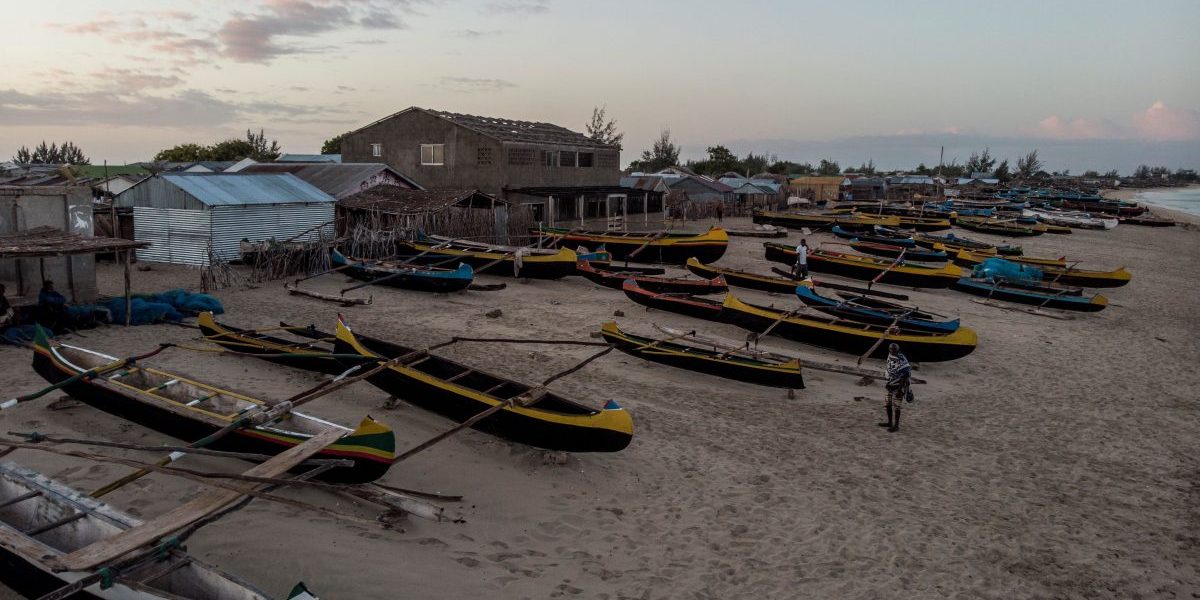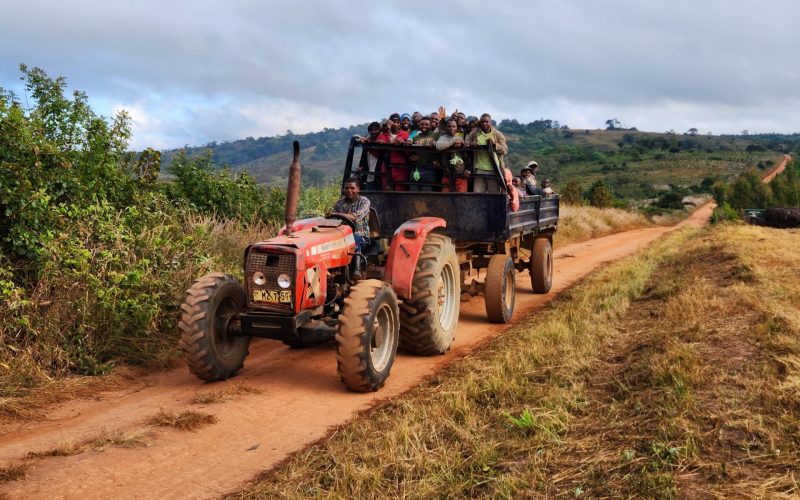Recommendations
- Technical and funding partners should engage in consultations that involve Locally Managed Marine Areas, other community-based marine and fisheries organisations and non-resident donors, in order to establish the enabling conditions for them to engage with community trust funds.
- Technical and funding partners should support the development of innovative financing for local communities and strengthen locally led trust funds such as Beolobe.
- In order to ensure their success and sustainability, community trust funds must have robust governance structures and practices.
- Technical and funding partners should lead the development of Blue Business incubators that support jobs and skills development using traditional knowledge within communities and develop bankable projects through matchmaking between community leaders, private entrepreneurs and investors.
Executive summary
Despite considerable conservation efforts and major international donor investments over the past three decades, Madagascar still faces growing natural resource degradation and biodiversity loss. Local communities remain economically disadvantaged and are vulnerable to natural and human-induced shocks. Because they are relatively unprotected, they have little motivation to act as environmental defenders and local conservation practitioners.
It is definitely time to drive innovation in terms of financing communities. This will empower local people to become part of the holistic solutions to the challenges they face. This briefing presents various examples – particularly the Beolobe regranting mechanism – of how this can be achieved, but the enabling environment for such an initiative needs to be strengthened. Local practitioners’ voices must be heard in shaping funding priorities and strategies, while technical and funding partners’ political will to support such solutions needs to be developed.
Introduction
Madagascar’s exceptionally high biodiversity means it plays an important role in mitigating emissions globally and in supporting ecological connectivity within the South-West Indian Ocean region. The country has the longest coastline of African countries and the fourth-largest Exclusive Economic Zone globally. Unfortunately, Madagascar’s ecosystems and the services they provide are threatened by pollution, overexploitation, destructive fishing practices, habitat destruction, inadequate enforcement of regulations and weak governance. The harmful effects of these threats are worsened by the impacts of climate change, such as rising sea temperatures, more frequent and intense extreme weather events and coastal erosion.1World Bank, Madagascar Country Environmental Analysis, Report (Washington DC: World Bank, January 2022).
Over the past 30 years, 4% of Madagascar’s territory, or almost 3.5 million ha of land, has been transferred to communities for local conservation initiatives. In 2012, on the initiative of non-governmental organisations (NGOs) in conservation and with the full support of local coastal communities and small-scale fishers, the MIHARI2The acronym MIHARI is derived from MItantana HArena and Ranomasina avy eny Ifotony, which translates to ‘marine resources management at the local level’. LMMA Network was established. MIHARI’s main objectives are to amplify the voices of local marine resource managers, to unite them and to facilitate their empowerment. With 280 individual LMMAs currently participating in the MIHARI Network, Madagascar is home to the first community management network model in the South-West Indian Ocean.
Empowering communities for sustainable conservation and development
Despite efforts to engage coastal communities in conservation and natural resource management, the country still faces increasing natural resource degradation and biodiversity loss. One of the biggest problems is that local communities remain economically disadvantaged and vulnerable to shocks such as natural disasters (notably cyclones), health issues, dwindling livelihood sources and acts of banditry, often leading to unsustainable exploitation of natural resources. Furthermore, many communities face the threat of land grabs by businesses and other powerful actors.3A new law on land tenure, 2021-016, has been adopted and is putting local people at risk of losing their land, threatening 5 million households. The law disadvantages local terrestrial and marine communities and opens the way to elites and investors’ cherrypicking areas for their own profit. Local conservation leaders also encounter security risks, including death threats and murder, from those involved in the illegal exploitation of natural resources. Communities are not sufficiently protected, which undermines their motivation to act as environmental defenders and local conservation practitioners.
Madagascar has benefited from the support of technical and funding partners4In Madagascar, the technical and funding partners include conservation NGOs (such as Conservation International, the Wildlife Conservation Society, World Wide Fund for Nature and Blue Ventures); the various projects and programmes, be they governmental or non-governmental, working on conservation and development (including USAID projects, EU projects and SWIOFish2); and resident donors, such as foreign embassies.over the past three decades in recognition of the importance of its unique and rich biodiversity, as well as its position as one of the poorest countries in the world.5Patrick O Waeber et al., “How Effective Have Thirty Years of Internationally Driven Conservation and Development Efforts Been in Madagascar?”, PLoS ONE 11, no. 8 (2016): 4. Despite this, it has lost 44% of its forest area from 1950–2014,6Ghislain Vieilledent et al., “Combining Global Tree Cover Loss Data with Historical National Forest Cover Maps to Look at Six Decades of Deforestation and Forest Fragmentation in Madagascar”, Biological Conservation 222 (2018): 189–197. and in 2023 was reportedly the country with the most threatened living species in the world, with nearly 3 800 species under threat of extinction.7Statista, “Leading Countries with the Most Threatened Species Worldwide as of 2023”, https://www.statista.com/statistics/1275491/ most-endangered-species-by-country/ Saving its biodiversity is an issue of global concern.
Local and Indigenous people play a key role in ensuring conservation successes because they hold unique and valuable knowledge about their environment. In addition, they live near and are dependent upon these natural resources. However, conservation projects in general do not address these communities’ primary needs and, even when they do, the scale is so limited that they do not provide meaningful solutions to communities’ problems. Rather, funding from technical and financial partners goes towards establishing protected areas, undertaking biodiversity conservation activities and implementing more activities aimed at protecting natural resources, which often limit communities’ access to such resources. As a result, some partners and conservation practitioners active in Madagascar feel that international conservation funding could be used far more effectively. Malagasy researchers and conservation NGOs working in the country have held collective reflection processes about this issue, but with no tangible outcomes as yet.
At the global level, some donors are increasingly recognising the need to directly and meaningfully empower communities in conservation efforts and are leading the way in creating the necessary shift. For instance, Andrew Steer, the CEO of Bezos Earth Fund, stated that ‘the most important things in the world that need doing cannot be done by large organizations. They will be done by many, sometimes hundreds, sometimes even thousands of smaller groups.’8Jim Rendon, “$5B Conservation Plan Offers New Approach, But Faces Hurdles”, City News Everywhere, September 29, 2021. Ameyali Ramos, Deputy Chair of the IUCN Commission on Environmental, Economic and Social Policy and who is involved in territories of life (as set out in the manifesto of the Indigenous Peoples and Community Conserved Territories and Areas Consortium),9Ameyali Ramos and Carola Rackete, “Conservation Happens Every Day”, Rosa Luxemburg Stiftung, June 20, 2022. has highlighted the need to shift the way money flows and address the power relationships between those who do the work and those who fund it. This emphasises the potential for Indigenous peoples and local communities to create theirown platforms for securing and managing funding.
Consultations we have undertaken in Madagascar have led us to conclude that there is significant potential for innovation around funding for local communities in ways that would increase their agency in the management of such funds. Related initiatives are beginning to emerge in Madagascar, but these will need to be strengthened. There should be a more enabling environment for regranting mechanisms, for example. While there is a clear demand within communities for such shifts, further work is required to develop the political will for the necessary changes within the broader network of stakeholders shaping conservation and development efforts in the country.
Local and international examples
The Community Land Rights and Conservation Initiative (CLARIFI) is a new global funding mechanism that aims to mobilise and deploy public and private funds ($10 billion by 2030) to secure community land tenure, conserve forests and biodiversity, safeguard traditional livelihoods and achieve gender rights. While CLARIFI aims to channel funds directly to initiatives led by Indigenous people and local communities, it is also designed to be jointly led by representatives and/or leaders of Indigenous, Afro-descendant and local community rights holders’ groups, as well as their allies and donors.
CLARIFI’s focus on empowering Indigenous and community rights holders to tap into new and existing funding is supported by the development of grant management protocols that satisfy both community needs and stringent donor requirements. Complying with donor requirements is frequently difficult for local organisations, which is a major barrier to channelling funds at scale to local communities. Recent studies have explored emerging best practice on how donors and intermediaries can adapt internal capacity and systems to promote greater inclusion of Indigenous peoples and local communities in order to deliver more effective funding.10Path to Scale and Rights+Resources, “Financing Rights-Based Climate and Conservation Solutions” (Summary Document, Rights+Resources, Montreal, 2022).
In Madagascar the Biodiversity and Protected Areas Fund (FAPBM) has been established as a trust fund for protected areas. It is endowed with capital invested in international markets, the income from which is used to finance the protected areas. This approach secures the sustainability of biodiversity funding over time. The FAPBM is currently working to preserve 64 protected areas covering over 5.3 million ha. It is the largest trust fund for biodiversity conservation in Africa, with invested capital of $150 million.11Madagascar Protected Areas and Biodiversity Fund, https://www.fapbm.org/en/home/
Conservation NGOs have expressed interest in adopting similar funding mechanisms. Blue Ventures, for instance, is establishing the Frontline Community Fund, which will provide flexible, multi-year funding and hands-on technical support to help participating groups develop from small, credible community-based organisations to mature, impactful organisations able to take on more direct financial support.12Frontline Community Fund, https://frontlinefund.org/ Beolobe is an emerging regranting mechanism in Madagascar. It aims to revise the topdown approach to conservation in the country and shift towards a bottom-up approach that empowers small-scale fishers to take the lead in designing and implementing projects that meet their needs. Beolobe intends to combine nature conservation with communityled development, creating a community trust fund that mobilises funders, investors, philanthropists and the private sector to support local community projects. In order to support its mission, it will launch a Coastal Business Incubator Fellowship programme.13Vatosoa Rakotondrazafy (Beolobe Community Trust Fund, Founder), interview by Harifidy Ralison, March 2024.
Risks associated with local community trust funds
Community trust funds can be a powerful tool in increasing conservation impacts and supporting local development. However, there are risks. Within the Malagasy context, some key risks include:
- insecure funds (owing to the limited use of digital money);
- possible embezzlement or fraud, coupled with low financial management capacity;
- literacy and language barriers;
- direct threats to the personal safety of environmental defenders;
- limited community sense of ownership of conservation activities and conflict of interests (owing to inadequate representation of communities within trust funds);
- operational discontinuity (owing to an absence of succession plans for community leadership roles); and
- challenges related to community organisations’ lack of legal status (owing to inadequate knowledge of administrative procedures and/or insufficient means for legal formalisation because of remoteness).
Higher-level risks are linked to legal and regulatory gaps and inconsistent enforcement, as well as a lack of clarity on the level of authority and responsibilities. Examples are the absence of laws to protect environmental defenders and whistleblowers and a lack of clarity on the powers of the Community Control and Surveillance Structures, formed mainly by community-appointed patrol agents.
Conclusion
Although there is significant potential for community-led conservation in Madagascar, current conservation practices involving communities have not worked as planned. Often, conservation and natural resource management projects implemented in the country struggle to achieve the expected results or ensure their sustainability. This is the result of insufficient consideration, understanding and integration of local needs and valuable local knowledge. Similar issues are observed in other parts of the world, where local practitioners’ voices are not meaningfully included in the shaping of funding priorities and strategies, thereby undermining the achievement of effective, just and lasting biodiversity outcomes.14Robert J Smith et al., “Let the Locals Lead”, Nature 462 (2009): 280–281; Nitin D Rai et al., “Beyond Fortress Conservation: The Long-Term Integration of Natural and Social Science Research for an Inclusive Conservation Practice in India”, Biological Conservation 254 (2021), quoted in Johanna Eklund et al., “Insights from Practitioners in Madagascar to Inform More Effective International Conservation Funding”, Madagascar Conservation & Development 17, no. 1 (2022): 29–35.
An enhanced bottom-up process is needed to allow full consideration of communities’ aspirations and basic needs in conservation fundings. Such an approach will be key in moving away from the current approach, which does not empower local communities to take initiative and become leaders. The idea of creating the Beolobe platform and network was born out of the above analysis, with a particular focus on small-scale fishers. Beolobe will be Madagascar’s first platform that brings together the island’s community led conservation initiatives, individuals or network/group structures to mobilise investments and resources in a way that prioritises local communities’ well-being and their guardianship of natural resources. Local communities, including those that form part of the MIHARI Network, are eager to engage in such an approach.
To put communities in the driver’s seat, Beolobe aims to motivate local stewards by combining efforts around conservation and addressing their wellbeing, ensuring that the small-scale fishers feel valued and recognised for their efforts. Its ambitions to facilitate matchmaking between community leaders and private entrepreneurs or investors to develop blue businesses will be instrumental in developing ones that are sustainable and inclusive. Bankable projects drawing on local entrepreneurship will form the backbone of livelihoods improvement at the local level while boosting the local economy.








